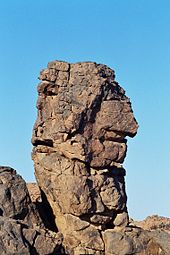Tadrart Acacus
| Rock paintings of Tadrart Acacus | |
|---|---|
|
UNESCO world heritage |
|

|
|
| Rock painting in the Tadrart Acacus |
|
| National territory: |
|
| Type: | Culture |
| Criteria : | iii |
| Reference No .: | 287 |
| UNESCO region : | Arabic states |
| History of enrollment | |
| Enrollment: | 1985 (session 9) |
Tadrart acacus (from the mazirischen ⵜⴰⴷⵔⴰⵔⵜ ⵏ ⴰⴽⴰⴽⵓⵙ tadrart n Akakus , "mountain of Akakus"; arabic تدرارت عكاكس, DMG Tadrārt ʿAkākus ) is a mountain range in southwest Libya . It is situated near the Libyan city of Ghat and near the rock massif Idinen . A southern branch is the Tassili Tadrart .
geography
The Akkakus or the Akkakus Mountains is a desert landscape in Libya . The mountain and desert city of Ghat can serve as access to the area .
Even in October, temperatures are still around 30 ° C in the shade. The desert itself is shaped by mountains, stones, sand and dunes. There are rock monuments similar to those in Arches National Park in the United States . In caves there are prehistoric engravings of elephants and water buffalo from around 4000 BC. They are similar to those in the Algerian Tassili Mountains . The paintings document periods in which the region was much more humid and thus offered a much more fertile landscape.
The labyrinthine mountain world is visited or populated by Tuareg , but also serves as a travel destination for tourists with a good constitution. When traveling to the region, a list of group participants is left at the departure point.
UNESCO world heritage
The petroglyphs in the Libyan part of the Tadrart in the 1985 UNESCO list of world heritage has been added. In 1958 the child mummy Uan Muhuggiag was found spectacularly . Since 1955, hundreds of rock carvings and thousands of drawings have been cataloged by Italian and Libyan archaeologists. They were created from the Pleistocene (12,000 to 8,000 BC) to the first century AD. Both the development of human society and the gradual climate changes from a savannah landscape through times with a more humid climate to today's desert can be followed in the scenes shown .
Destruction of the rock carvings
In April 2014, some of the rock carvings were destroyed by Libyan jihadists using petroleum ether .
Picture gallery
literature
- C. Carrara, M. Cremaschi, Y. Quinif: The travertine deposits in the Tadrart Acacus (Libyan Sahara) nature and age, in: M. Cremaschi, S. di Lernia (ed.): Wadi Teshuinat - Palaeoenvironment and Prehistory in Southwestern Fezzan (Libyan Sahara) , Rome, Milan 1998, pp. 59-66.
- Savino Di Lernia, Daniela Zampetti (eds.): La Memoria dell'Arte. Le pitture rupestri dell'Acacus tra passato e futuro , Florence 2008.
- David Mattingly: Twelve thousand years of human adaptation in Fezzan (Libyan Sahara) , in: Graeme G. Barker, DD Gilbertson (eds.): The Archeology of Drylands: Living at the Margin , Routledge, London 2000, pp. 160-179 .
- Anna Maria Mercuri: Plant exploitation and ethnopalynological evidence from the Wadi Teshuinat area (Tadrart Acacus, Libyan Sahara) , in: Journal of Archaeological Science 35 (2008) 1619–1642.
- Anna Maria Mercuri: Human influence, plant landscape evolution and climate inferences from the archaeobotanical records of the Wadi Teshuinat area (Libyan Sahara) , in: Journal of Arid Environments 72 (2008) 1950–1967.
Web links
- Entry on the UNESCO World Heritage Center website ( English and French ).
- The Archaeological Mission in the Sahara , Italian website of the Sapienza, Rome (acacus.org)
Individual evidence
- ↑ Libye, 12 000 ans effacés au white spirit ( page no longer available , search in web archives ) Info: The link was automatically marked as defective. Please check the link according to the instructions and then remove this notice. , in: Monde Afrique, April 20, 2014.
Coordinates: 25 ° 0 ' N , 10 ° 20' E







